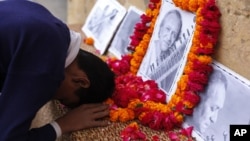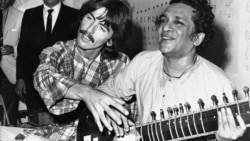World-renowned sitar player Ravi Shankar, one of the greatest ambassadors of Indian music, has died in San Diego, near his Southern California home. He was 92 years old. Shankar, a master of the sitar, a multi-stringed, Indian classical instrument, helped popularize its use in the west.
Shankar was a recognized master of classical Indian music, an art form with roots that extend back more than 4,000 years. Through his contact with musicians of different cultures, Shankar was the first to introduce Indian music to western, mainstream audiences. Over his eight-decade career, he became a worldwide musical icon, especially through his work with the Beatles, and was labeled the “godfather of world music” by no less than George Harrison.
The Indian prime minister’s office confirmed Shankar’s death and called him a “national treasure.”
Ravi Shankar was born in India and began his musical career in the 1930s, studying music and dance. At the age of 10, he moved to Paris to join his brother, the leader of a respected Indian dance troupe. He spent the next eight years traveling with the troupe across America, Europe and Asia. During that time, Ravi Shankar heard and met western music stars such as Duke Ellington, Louis Armstrong and Cole Porter. Later, he decided to return to India and embark on a course of intensive study with a sitar master.
Shankar played his first U.S. concert in 1956, introducing the western audiences to ragas, a complex Indian musical form often enhanced with drums and other instruments. He explained how each raga has its own personality, whether happy, sad, erotic or devotional. Shankar believed that, to effectively play a raga, a musician must have harmony within himself, follow the musical structure, and join in harmony with others.
"The basis of the system that's known as the raga is the melody forms -- hundreds and thousands of them," said Shankar. "They have their own ascending and descending structure. They're pentatonic, hexatonic or using all the seven notes, and different permutations and combinations. But the question of spirituality is something else. It is being trained from the very beginning to be at peace yourself when you perform."
But it was his relationship with George Harrison and the Beatles that brought Ravi Shankar to worldwide attention in the 1960s. George Harrison had grown fascinated with the sitar, an instrument that sort of resembles a giant lute. It has a long neck and a gourd for a body. Harrison studied with Shankar and brought the sitar sound into several of The Beatles recordings, as well as his solo work.
Soon, Ravi Shankar was playing in concerts with some of the top rock bands of the times and was featured at both the Monterey Pop and Woodstock Festivals.
But Ravi Shankar will be remembered for more than just playing the sitar. In 1971, he pioneered the concept of the benefit rock concert. Moved by the plight of millions of refugees fleeing into India to escape war in Bangladesh, Shankar reached out to George Harrison to see what they could do to help. The pair organized two benefit concerts at Madison Square Garden in New York City with artists that included Bob Dylan, Ringo Starr and Eric Clapton.
Sales from the Grammy-winning “Concert for Bangladesh” album raised more $15 million for refugees and children.
In all, Shankar won three Grammy awards and will be honored with The Recording Academy’s Lifetime Acheivement Award next February. Other honors included an Oscar nomination for his musical score for the movie “Gandhi.”
Brian Q. Silver, an ethnomusicologist and former VOA World Music Curator, was asked if it was possible to overestimate Ravi Shankar’s importance and influence.
“I don’t think so. First of all, the music is so great and he was such an extraordinary international ambassador," he said. "Yehudi Menuin saw it back in the early 1950s. I spoke with the late Yehudi Menuin about why he brought him to New York. And it was very clear: because this is a tradition that the West didn’t have a clue about and is fully as distinguished and developed and sophisticated as any classical Western tradition. Except that it is improvised - which makes it even more exciting and that’s where the jazz connection came in. People like John Coltrane picked it up and so many other jazz musicians, I can’t even begin to name them. So, he came in both through the Western classical portal and the jazz portal. And then, of course, pop when George Harrison discovered him. That’s what brought Indian music to the west.”
Until recently, Ravi Shankar kept an active schedule of concerts and some teaching. He was bestowed countless honors and awards from countries around the world, and even served a six-year term in India's Parliamentary Upper Chamber.
He is survived by his wife Sukanya and two daughters: sitar player Anoushka Shankar and jazz singer and pianist Norah Jones.
Shankar was a recognized master of classical Indian music, an art form with roots that extend back more than 4,000 years. Through his contact with musicians of different cultures, Shankar was the first to introduce Indian music to western, mainstream audiences. Over his eight-decade career, he became a worldwide musical icon, especially through his work with the Beatles, and was labeled the “godfather of world music” by no less than George Harrison.
The Indian prime minister’s office confirmed Shankar’s death and called him a “national treasure.”
Ravi Shankar was born in India and began his musical career in the 1930s, studying music and dance. At the age of 10, he moved to Paris to join his brother, the leader of a respected Indian dance troupe. He spent the next eight years traveling with the troupe across America, Europe and Asia. During that time, Ravi Shankar heard and met western music stars such as Duke Ellington, Louis Armstrong and Cole Porter. Later, he decided to return to India and embark on a course of intensive study with a sitar master.
Shankar played his first U.S. concert in 1956, introducing the western audiences to ragas, a complex Indian musical form often enhanced with drums and other instruments. He explained how each raga has its own personality, whether happy, sad, erotic or devotional. Shankar believed that, to effectively play a raga, a musician must have harmony within himself, follow the musical structure, and join in harmony with others.
"The basis of the system that's known as the raga is the melody forms -- hundreds and thousands of them," said Shankar. "They have their own ascending and descending structure. They're pentatonic, hexatonic or using all the seven notes, and different permutations and combinations. But the question of spirituality is something else. It is being trained from the very beginning to be at peace yourself when you perform."
But it was his relationship with George Harrison and the Beatles that brought Ravi Shankar to worldwide attention in the 1960s. George Harrison had grown fascinated with the sitar, an instrument that sort of resembles a giant lute. It has a long neck and a gourd for a body. Harrison studied with Shankar and brought the sitar sound into several of The Beatles recordings, as well as his solo work.
Soon, Ravi Shankar was playing in concerts with some of the top rock bands of the times and was featured at both the Monterey Pop and Woodstock Festivals.
But Ravi Shankar will be remembered for more than just playing the sitar. In 1971, he pioneered the concept of the benefit rock concert. Moved by the plight of millions of refugees fleeing into India to escape war in Bangladesh, Shankar reached out to George Harrison to see what they could do to help. The pair organized two benefit concerts at Madison Square Garden in New York City with artists that included Bob Dylan, Ringo Starr and Eric Clapton.
Sales from the Grammy-winning “Concert for Bangladesh” album raised more $15 million for refugees and children.
In all, Shankar won three Grammy awards and will be honored with The Recording Academy’s Lifetime Acheivement Award next February. Other honors included an Oscar nomination for his musical score for the movie “Gandhi.”
Brian Q. Silver, an ethnomusicologist and former VOA World Music Curator, was asked if it was possible to overestimate Ravi Shankar’s importance and influence.
“I don’t think so. First of all, the music is so great and he was such an extraordinary international ambassador," he said. "Yehudi Menuin saw it back in the early 1950s. I spoke with the late Yehudi Menuin about why he brought him to New York. And it was very clear: because this is a tradition that the West didn’t have a clue about and is fully as distinguished and developed and sophisticated as any classical Western tradition. Except that it is improvised - which makes it even more exciting and that’s where the jazz connection came in. People like John Coltrane picked it up and so many other jazz musicians, I can’t even begin to name them. So, he came in both through the Western classical portal and the jazz portal. And then, of course, pop when George Harrison discovered him. That’s what brought Indian music to the west.”
Until recently, Ravi Shankar kept an active schedule of concerts and some teaching. He was bestowed countless honors and awards from countries around the world, and even served a six-year term in India's Parliamentary Upper Chamber.
He is survived by his wife Sukanya and two daughters: sitar player Anoushka Shankar and jazz singer and pianist Norah Jones.










